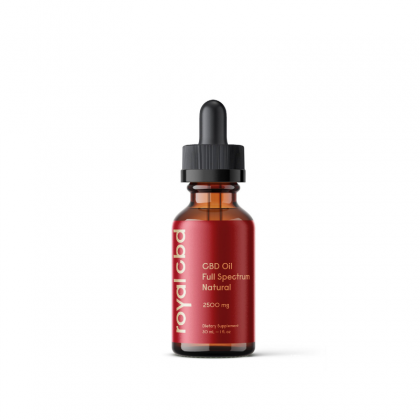| Total CBD: | 500 – 2500 mg |
| Potency: | 16.6 - 83.3 mg/mL |
| Cost per mg CBD: | $0.12 – $0.18 |
| Extract Type: | Full-spectrum |
| THC Content: | <0.3% |

Evidence based
CBD For Metabolic Syndrome: What the Research Says
CBD offers several benefits for metabolic syndrome & blood sugar regulation.
Here’s how it works.
Metabolic syndrome is a dysfunction of energy production and storage in the body. The body loses its ability to maintain blood sugar levels effectively, and fat storage goes into overdrive.
CBD offers a variety of benefits for people with metabolic syndrome — addressing both the underlying cause and some of the common side-effects of the condition.
Here, we’ll go over what metabolic syndrome is, how it works, and how you can use CBD to alleviate symptoms and slow the progression of the disease.
What Are The Benefits of CBD Oil For Metabolic Syndrome?
CBD can be used to resist the changes taking place as a result of metabolic syndrome in three main ways: it protects the liver from fatty liver disease, supports weight loss by curbing hunger cravings, and addresses some of the most common side-effects of the condition.
The benefits of CBD oil for metabolic syndrome include:
- Promotes weight loss by lowering appetite
- Protects the liver from damage caused by fatty liver disease
- Improves insulin sensitivity to regulate blood sugar levels better
- Alleviates neuropathic pain
- Protects the insulin-secreting cells of the pancreas
- Lowers inflammation
1. Protects the Liver
One of the driving factors of metabolic syndrome is the accumulation of fat in the liver (fatty liver disease) — which gradually damages the liver. If the problem goes on for too long, scar tissue accumulates, eventually leading to liver failure.
CBD can be used to resist liver damage through its involvement with the endocannabinoid system.
Studies have shown that the endocannabinoid system is involved with protecting the liver from damage. Unfortunately, with fatty liver disease, this system works against the liver instead.
Studies suggest CBD can turn down the effects of the endocannabinoid system in the liver to slow the progression of the disease [1].
Benefits of supporting liver function through the endocannabinoid system include:
- Lowering cholesterol levels
- Lowering blood triglyceride levels
- Reducing inflammation
- Improving liver function
- Slowing the progression of the disease
2. May Promote Weight Loss
One of the causes of metabolic syndrome is consuming more energy than the body needs. This leads to increased weight gain in the form of fat.
Reducing food intake is one of the primary treatments for metabolic syndrome. CBD offers direct benefits toward this by interacting with the hormones involved with hunger [2]. CBD can reduce appetite and lower the number of calories we consume in a day.

By curbing appetite, we can slow the progression of metabolic syndrome. It takes some of the strain off the liver as it tries to remove excess sugar from the blood.
3. May Alleviate Common Side-Effects of Metabolic Syndrome
Metabolic syndrome affects other organs in the body, especially in the later stages of the condition.
Some of the side-effects that result can be alleviated or supported through CBD supplementation.
Here are a few examples of related conditions that can be improved with supplemental CBD:
- Nerve pain
- Skin conditions
- Neurodegenerative disorders
- Diabetes
- Fatty liver disease
- Irritable bowel syndrome
- Inflammatory bowel disease
- Alzheimer’s disease
- Arthritis
- Kidney disease
- Osteoporosis
What Form of CBD Should I Use?
CBD comes in many different forms. There’s oils, capsules, edibles, and vape liquids.
Virtually all oral CBD is going to work because it brings CBD and related cannabinoids into the bloodstream. Once in the bloodstream, they can interact with the brain, pancreas, and liver — where most of the impact of metabolic syndrome takes place.
With that said, we recommend staying away from all edibles and using a CBD oil, a tincture, or capsules.
This is because most edibles are high in sugar, which is the underlying cause of the metabolic syndrome. Therefore, if taking CBD with the goal of improving the condition, the last thing you want to do is take CBD in a form that could make the condition even worse.
What’s The Dose of CBD Oil For Metabolic Syndrome?
Determining the dose of CBD can be a challenge since the compound affects everybody differently. Some people need a high dose; others need a low dose to achieve the same results.
In general, the dose of CBD needed for metabolic syndrome is on the higher end of the scale.
Most of the research on using CBD for blood sugar control and treating fatty liver disease also involves higher doses.
We recommend starting with the low-strength dose and building up gradually to the high-strength dose over the course of a week or two. If no side-effects are experienced, remain at a higher dose.
CBD Dosage Calculator
How Long Should I Take CBD for Metabolic Syndrome?
Metabolic syndrome is a chronic health condition — meaning it takes a long time to develop and a long time to get rid of.
Therefore, CBD should be used over the long term to get the most out of the protective effects of the compound.
Of course, dietary and lifestyle modifications are also critical changes to make when treating metabolic syndrome. CBD alone won’t fix the condition — only slow its progression. It’s critical that you seek advice from a doctor — and nutritionist or dietician — to make the changes necessary for putting a halt to metabolic syndrome.
You should expect treatment for this condition to take a year or more. It requires a shift in your lifestyle over the long term — not a short-lived diet or exercise commitment. CBD is simply one added component to this shift to make it even more effective.
What Are The Side-Effects of CBD?
Although CBD has been proven to be highly safe many times over, it’s important to know about its potential side-effects. Everybody is different, and what works for one person doesn’t always work the same way for another.
Some of the most common side-effects of CBD:
- Appetite suppression
- Diarrhea
- Drowsiness
- Dry mouth
- Lightheadedness
- Lower heart rate
- Sedation

Tips for Getting the Most from CBD for Metabolic Syndrome
1. Be Consistent with Dosing
Metabolic syndrome didn’t appear overnight, and it won’t leave overnight either. Use CBD and other treatments consistently for several months.
2. Use High-Quality CBD Products Only
CBD is not regulated in most countries. Therefore, there are a lot of poor-quality products. It’s important to avoid these because they may contain ineffective doses of CBD or contaminants that can make the problem worse.
3. Consult Your Doctor Before Using CBD
Some medications may interact negatively with CBD, so it’s important to consult your doctor before using this supplement — especially if taking other medications.
What is Metabolic Syndrome?
Metabolic syndrome is a condition affecting homeostasis — which is a fancy word that means balance. “Homeo” means “self,” and “stasis” means “stays the same.” Therefore, homeostasis is when the body works to keep itself in the same state.
This applies to almost every aspect of human function, including our blood sugar levels, body temperature, blood pressure, breath rate, and hormone levels. All organ systems have ideal metrics that the body works very hard to maintain.
Our energy metabolism system also has an ideal range — we have specific concentrations of insulin and blood sugar that the body tries to keep level. If it goes too low, we pass out and can enter a coma; if it’s too high, it can cause irreversible damage to our heart, lungs, skin, and kidneys.
Metabolic syndrome is a condition involving an inability to maintain this balance.
When this system becomes dysfunctional, we begin to store excess fat around the internal organs such as the liver in an attempt to keep blood sugar levels stable by converting it into fat.
Metabolic syndrome is a collection of related symptoms involved with our metabolic system. A metabolic system is a group of organs that work together to regulate the body’s energy storage and production. It involves careful coordination of the digestive tract, pancreas, and liver. Other organs are also involved (such as the thyroid gland, adrenal gland, and fat cells), but play a smaller role.
People with metabolic syndrome experience gradual weight gain around the midsection of the body, lowered energy levels, and, eventually, changes in biochemistry such as blood sugar levels, blood lipid levels, and cholesterol.
If the condition goes on for too long, it will eventually result in fatty liver disease and diabetes.

In order to understand how metabolic syndrome works — and how CBD can support it — we need to discuss how energy homeostasis works in the body.
Step 1. The Digestive System
The digestive system is the first step in the process of producing energy for the body. When we eat a meal, it’s broken down into its sugars, fats, proteins, and other nutrients. These nutrients are then moved into the bloodstream.
Step 2. The Pancreas
As sugar is absorbed by the digestive system, the pancreas releases the hormone insulin to regulate blood sugar levels. Our body strives to maintain blood sugar levels between 4.0 to 5.4 mmol/L. Immediately following a meal, blood sugar levels spike as the sugar is absorbed into the bloodstream.
Insulin’s job is to begin moving a lot of this sugar into the cells, where it can be converted into energy.
This is where the problem starts for people with metabolic syndrome.
People with metabolic syndrome often have what’s called hyperinsulinemia — meaning “too much insulin.” This happens when insulin stops working the way it should in the body. The pancreas then needs to secrete increasing amounts of insulin into the blood to get the same job done.
As insulin stops working to move sugar into the cells, our blood sugar levels begin to rise above the ideal range of 4.0 to 5.4 mmol/L. When this happens, the liver needs to step in. If blood sugar levels spike too high, it becomes toxic, destroys blood cells, and damages the skin, kidneys, cardiovascular system, and lungs.
Step 3. The Liver
Energy metabolism is also regulated by the liver. It’s tasked with managing fat metabolism primarily but also buffers blood sugar levels by secreting hormones and storing excess sugar for when we start running low.
When blood sugar levels dip below the 4.0 mmol/L mark, it releases stored sugar to raise it to the ideal range. It also steps in to convert stored fat into useable energy for the body.
The liver is also responsible for lowering blood sugar levels when insulin cannot — such as with metabolic syndrome.
The liver does this by converting sugar into fat — which is more stable.
Unfortunately, if this happens too often, fat will start to build up inside the liver — leading to a condition known as fatty liver disease. This condition is a hallmark of metabolic syndrome and is what leads to other problems such as high blood pressure, high cholesterol, and high triglyceride levels.
Additionally, as more fat builds up in the liver, we become less capable of keeping blood sugar levels down, leading to diabetes.
What Causes Metabolic Syndrome?
The primary cause of the condition is diet-related. Meals high in refined carbohydrates and low in other macronutrients and micronutrients over many years will eventually result in metabolic syndrome.
Foods high in refined, simple sugars are absorbed very quickly in the digestive tract. This causes a spike in blood sugar levels immediately following a meal. This makes us feel energized immediately.

The body responds to this increase in blood sugar by dumping large amounts of insulin into the blood. Insulin moves the sugar into the cells, and blood sugar levels begin to drop. If we don’t have any complex sugars in our digestive tract to release sugar into the bloodstream, blood sugars drop too quickly and make us feel tired. This is why we often feel tired about 30 minutes after eating a meal.
The body doesn’t like having blood sugar levels spiking and dropping so dramatically — it prefers to maintain an even level throughout most of the day. Therefore, the body will make changes to keep blood sugar levels more stable. One of the ways it does this is by hiding insulin receptors on the cells. This means that the insulin we release will have less effect the next time we eat a meal.
Over many years, the body becomes more resistant to insulin — eventually, we reach a point where we can no longer rely on insulin to do its job effectively. This is when symptoms of metabolic syndrome begin appearing.
Symptoms of metabolic syndrome
- Fatigue
- Abdominal fat deposition
- Hypercholesterolemia (high cholesterol levels)
- Hypertriglyceridemia (high triglyceride levels)
- Hyperglycaemia (high blood sugar)
- Hyperinsulinemia (high insulin levels)
- Insulin resistance
- Lowered immunity
- Sweet or salty cravings
- Hypertension (high blood pressure)
- Digestive disturbances (diarrhea or constipation)
Long-term health consequences of metabolic syndrome
- Liver damage (fatty liver disease)
- Obesity
- Inflammation
- Increased risk of developing diabetes
- High cholesterol and triglyceride levels
What Does the Research Say?
An Australian study covering roughly 1.5 million people between the ages of 18 and 64 investigated the effects of cannabis on mental health [3]. Upon completing the study, researchers investigated the correlation of the data with incidences of metabolic syndrome. They found that people who used cannabis had a significantly lower chance of developing metabolic syndrome than non-users.
Researchers in the study concluded: “We found that frequent cannabis users were significantly less likely to meet each of the five metabolic syndrome criteria than participants reporting no cannabis use.”
Diet & Lifestyle Recommendations for Metabolic Syndrome
As we’ve mentioned throughout the article, diet and lifestyle modifications should be the primary treatment for this condition [4].
Some of the main diet and lifestyle modifications to consider are:
- Cut out processed foods from the diet (prepackaged meals, candy, white bread/pasta, etc.).
- Exercise at least 30 minutes 5 days a week (walking, running, weight lifting, etc.).
- Achieve ideal weight (limit calorie intake, exercise, etc.).
- Regularly measure blood glucose levels.
Will CBD Interact With Medications for Metabolic Syndrome?
CBD can sometimes lead to adverse interactions when combined with drugs used for treating metabolic syndrome and related health conditions.
There are a lot of medications that may be used for treating this condition. These medications are primarily aimed at improving quality of life and limiting the progression of the disease. The prescriptions given by your doctor depend entirely on your primary symptoms.
Here are a few common prescription medications given to metabolic syndrome patients that may interact with CBD:
- Biguanides (such as Metformin)
- Thiazolidinediones (such as Rosiglitazone)
- Statins (such as Artorvastatin)
- ACE Inhibitors (such as Captopril)
- Angiotensin II Receptor Blockers (such as Candesartan)
- Blood-Thinners (such as Warfarin)
Final Verdict: CBD for Metabolic Syndrome
Metabolic syndrome is a progressive dysfunction of the metabolic system. As sugar levels rise and fall out of control, the liver steps in to compensate. This results in fat deposits in the liver — leading to reduced function of this vital organ.
Treating metabolic syndrome relies primarily on diet and lifestyle changes (high fiber, low sugar diets, and regular exercise). CBD is an excellent add-on supplement for this condition to slow the progression of the disease and repair liver function. It’s also useful for lowering appetite to support weight loss — another critical step to take when treating metabolic syndrome.
We recommend finding high-quality CBD oils or capsules. However, stay away from high-sugar CBD edibles with this condition. To find the best dose, start low and build up to the high-strength dose. If no side-effects are reported at a high dose, this is where you should remain.
In conclusion, take CBD daily alongside diet and lifestyle changes for best results.
References Cited In This Article
- Purohit, V., Rapaka, R., & Shurtleff, D. (2010). Role of cannabinoids in the development of fatty liver (steatosis). The AAPS journal, 12(2), 233-237.
- Matias, I., & Di Marzo, V. (2006). Endocannabinoid synthesis and degradation, and their regulation in the framework of energy balance. Journal of endocrinological investigation, 29(3), 15.
- Waterreus, A., Di Prinzio, P., Watts, G. F., Castle, D., Galletly, C., & Morgan, V. A. (2016). Metabolic syndrome in people with a psychotic illness: is cannabis protective?. Psychological medicine, 46(8), 1651-1662.
- Dalle Grave, R., Calugi, S., Centis, E., Marzocchi, R., El Ghoch, M., & Marchesini, G. (2010). Lifestyle modification in the management of the metabolic syndrome: achievements and challenges. Diabetes, metabolic syndrome and obesity: targets and therapy, 3, 373.
- Eckel, R. H., Grundy, S. M., & Zimmet, P. Z. (2005). The metabolic syndrome. The lancet, 365(9468), 1415-1428.
- Alberti, K. G. M., Zimmet, P., & Shaw, J. (2005). The metabolic syndrome—a new worldwide definition. The Lancet, 366(9491), 1059-1062.
More Health Benefits to Explore
-
Conditions Related to Health Benefits
- CBD For Allergies: Can This Cannabinoid Ease Symptoms?
- Top 10 CBD Oils For Back Pain
- Can CBD Help With Menstrual Cramps?
- CBD for Sciatica: How It Works, Safety, Drug Interactions, & Best Products
- Is CBD a Viable Treatment for Cerebral Palsy?
- CBD Oil For Sleep
- CBD For Psoriasis: Can CBD Help to Alleviate Symptoms?
- Traumatic Brain Injury (TBI)
- Arthritis
- Anxiety & Depression
- Weight Loss
- ADD & ADHD
- Anorexia
- Alzheimer’s Disease & Dementia
- Addiction
- ALS (Amyotrophic Lateral Sclerosis)
- Antibiotic Resistance
- Asthma
- Atherosclerosis
- Autism
- Acne
- Bipolar Disorder
- Pain
- Crohn's Disease & Ulcerative Colitis
- Diabetes
- Epilepsy
- Endocrine Disorders
- Fibromyalgia
- Fatty Liver Disease
- Glaucoma
- Hypertension
- Heart Disease
- Huntington's Disease
- Inflammation
- Irritable Bowel Syndrome (IBS)
- Kidney Disease
- Migraine Headaches
- Muscle Recovery
- Multiple Sclerosis
- Motion Sickness
- Metabolic Syndrome
- Neurodegeneration
- Cancer
- Nausea
- Neuropathic (Nerve) Pain
- Osteoporosis/Bone Health
- Obsessive-Compulsive Disorder (OCD)
- Polycystic Ovarian Syndrome (PCOS)
- PTSD
- Prion/Mad Cow Disease
- Premenstrual Syndrome (PMS)
- Parkinson’s Disease
- Schizophrenia
- Sickle Cell Anemia
- Stroke
-
Conditions Related to Products
- Ranking The Top 13 THC Gummies By Category (Δ8, Δ9, Δ10, HHC, & More)
- Top 10 CBD Oils For Back Pain
- Everything You Need to Know About CBD Sunscreen
- Top 7 CBD Gummies For Sleep & Insomnia
- Top 7 CBD Gummies To Help With Anxiety (2022)
- Best CBD Gummies For Pain (Top-Rated Pain Gummies For 2022)
- Best Hemp Cigarettes (Top 5 Nicotine-Free Smokes)
- Top 5 CBD Lip Balms For 2022
- The Top 7 CBD Face Masks for 2022
- The Best CBD Inhalers For 2022 (& How to Use Them)
- Best Full-Spectrum CBD Vape Juice: What to Look For & How to Use It
- CBD Eye Drops: New Option For Glaucoma?
- CBD Oil For Dogs With Arthritis
- Best CBD Massage Oils In 2022
- Buyer's Guide To The Best CBD Vape Kits In 2022
- CBD Chocolate: Yes, It Exists & It's Just as Divine as it Sounds
- CBD Pre-Rolls & Cigarettes
- Terpene Concentrates
- Best CBD Soaps
- Best CBD Shampoo & Conditioner
- Best CBD Juul Pods
- CBD Isolate Oils
- Full-Spectrum CBD Oils
- Best CBD Lube
- CBD Honey
- CBD Transdermal Patches
- Best Dry Herb Vaporizers
- CBD Oil For Dogs With Epilepsy
- CBD Oil For Dogs With Anxiety
- CBD Oil For Dogs With Cancer
- CBD For Horses
- CBD Chewing Gum
- CBD Pain Cream
- CBD Oil For Cats
- CBD Oil For Dogs
- CBD Hemp Flower
- CBD Suppositories
- Best CBD Gummies for Pain, Sleep & Anxiety Reviewed (2022)
- CBD Teas
- CBD Vape Pens
- CBD Vape Oils
- CBD Coffee
- CBD Drinks & Shots
- CBD Crystals
- CBD Skincare
- Best CBD Oil & Gummies For Kids: Is CBD Safe for Children with Anxiety & ADHD?
- CBD Concentrates
- CBD Bath Bombs
- CBD Capsules
- CBD Sprays
- CBD Dog Treats
-
Conditions Related to Topicals
-
Conditions Related to Oils & Tinctures
-
Conditions Related to Edibles
- Top 7 CBD Gummies To Help With Anxiety (2022)
- Best CBD Gummies For Pain (Top-Rated Pain Gummies For 2022)
- CBD Chocolate: Yes, It Exists & It's Just as Divine as it Sounds
- CBD Honey
- CBD Chewing Gum
- Best CBD Gummies for Pain, Sleep & Anxiety Reviewed (2022)
- CBD Teas
- CBD Coffee
- CBD Drinks & Shots
- CBD Capsules
-
Conditions Related to Gummies
- Ranking The Top 13 THC Gummies By Category (Δ8, Δ9, Δ10, HHC, & More)
- Top 7 CBD Gummies For Sleep & Insomnia
- Top 7 CBD Gummies To Help With Anxiety (2022)
- Best CBD Gummies For Pain (Top-Rated Pain Gummies For 2022)
- Best CBD Gummies for Pain, Sleep & Anxiety Reviewed (2022)
- Best CBD Oil & Gummies For Kids: Is CBD Safe for Children with Anxiety & ADHD?
-
Conditions Related to Hemp Flower
-
-
Conditions Related to Terpenes
-
-
Conditions Related to Cultivation
-
Conditions Related to Concentrates
-
Conditions Related to Delta 8 THC
-
Conditions Related to Delta 9 THC
-
-
-
-
Conditions Related to CBD
- Everything You Need to Know About CBD Sunscreen
- Top 7 CBD Gummies For Sleep & Insomnia
- Top 7 CBD Gummies To Help With Anxiety (2022)
- Best CBD Gummies For Pain (Top-Rated Pain Gummies For 2022)
- Best Hemp Cigarettes (Top 5 Nicotine-Free Smokes)
- Top 5 CBD Lip Balms For 2022
- The Top 7 CBD Face Masks for 2022
- The Best CBD Inhalers For 2022 (& How to Use Them)
- Best Full-Spectrum CBD Vape Juice: What to Look For & How to Use It
- CBD Eye Drops: New Option For Glaucoma?
- CBD Oil For Dogs With Arthritis
- Best CBD Massage Oils In 2022
- Buyer's Guide To The Best CBD Vape Kits In 2022
- CBD Chocolate: Yes, It Exists & It's Just as Divine as it Sounds
- CBD Pre-Rolls & Cigarettes
- Best CBD Soaps
- Best CBD Shampoo & Conditioner
- Best CBD Juul Pods
- CBD Isolate Oils
- Full-Spectrum CBD Oils
- Best CBD Lube
- CBD Honey
- CBD Transdermal Patches
- CBD Oil For Dogs With Epilepsy
- CBD Oil For Dogs With Anxiety
- CBD Oil For Dogs With Cancer
- CBD For Horses
- CBD Chewing Gum
- CBD Pain Cream
- CBD Oil For Cats
- CBD Oil For Dogs
- CBD Hemp Flower
- CBD Suppositories
- Best CBD Gummies for Pain, Sleep & Anxiety Reviewed (2022)
- CBD Teas
- CBD Vape Pens
- CBD Vape Oils
- CBD Coffee
- CBD Drinks & Shots
- CBD Crystals
- CBD Skincare
- Best CBD Oil & Gummies For Kids: Is CBD Safe for Children with Anxiety & ADHD?
- CBD Concentrates
- CBD Bath Bombs
- CBD Capsules
- CBD Sprays
- CBD Dog Treats
-
-
Conditions Related to THC-O
-
-
Conditions Related to Joint Health
-
Conditions Related to Pain Disorders
- Top 10 CBD Oils For Back Pain
- Can CBD Help With Menstrual Cramps?
- CBD for Sciatica: How It Works, Safety, Drug Interactions, & Best Products
- Traumatic Brain Injury (TBI)
- Arthritis
- Pain
- Fibromyalgia
- Glaucoma
- Inflammation
- Kidney Disease
- Migraine Headaches
- Multiple Sclerosis
- Neuropathic (Nerve) Pain
- Premenstrual Syndrome (PMS)
- Sickle Cell Anemia
-
Conditions Related to Autoimmune Disease
-
Conditions Related to Cognitive Health
-
Conditions Related to Metabolic Disorders
-
Conditions Related to Psychological Disorders
-
Conditions Related to Muscles & Bones
-
Conditions Related to Nervous System
- CBD for Sciatica: How It Works, Safety, Drug Interactions, & Best Products
- Is CBD a Viable Treatment for Cerebral Palsy?
- CBD Oil For Sleep
- Traumatic Brain Injury (TBI)
- Anxiety & Depression
- ADD & ADHD
- Anorexia
- Alzheimer’s Disease & Dementia
- Addiction
- ALS (Amyotrophic Lateral Sclerosis)
- Autism
- Bipolar Disorder
- Epilepsy
- Huntington's Disease
- Inflammation
- Migraine Headaches
- Multiple Sclerosis
- Motion Sickness
- Neurodegeneration
- Neuropathic (Nerve) Pain
- Obsessive-Compulsive Disorder (OCD)
- PTSD
- Prion/Mad Cow Disease
- Parkinson’s Disease
- Schizophrenia
-
-
Conditions Related to Reproductive Health
-
Conditions Related to Hormones & Endocrine
-
Conditions Related to Skin Health
-
Conditions Related to Cardiovascular System
-
Conditions Related to Digestive System
-
Conditions Related to Genetic Disorders
-
Conditions Related to For Children









